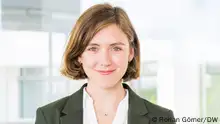Diversity
Portrayal of people with disabilities in the media
Katharina Brauner is a 23-year-old student of deaf studies in Berlin. In our interview, she talks about the special features of sign language and the portrayal of people with disabilities in the media.
Presenting disability as a social normality
According to the Federal Statistical Office, 10.4 million people with a disability lived in Germany at the end of 2019, with almost 8 million living with severe disabilities. These persons make up to 9.5% of the population.
However, many people are unaware of the challenges and barriers that people with disabilities face. The media can be instrumental in creating more visibility on the situation of people with disabilities and at the same time, present disability as a social normality. Therefore, media have a key role to play in the development of an inclusive society. The public media, in particular, have the mandate to adequately prepare information for the entire society in its diversity. They consequently bear a great responsibility to contribute to greater social participation of people with disabilities through their diverse program offerings. At the same time, access to and use of media is often associated with various barriers, especially for deaf people.
Showing diverse perspectives of people with disabilities
So what role does inclusion play in program content and to what extent is an authentic and equal participation of people with disabilities in society depicted in the media offerings?
Katharina sees potential for improvement here, especially for the sign language community. For deaf people, this means above all that sign language interpreters are shown and subtitles are used. This is far too seldom the case, says the student. She also expects barriers to be broken down and different perspectives of people with disabilities to be portrayed so that a more authentic picture emerges. "It is essential to include sign language experts who know what we as deaf people are capable of, what we need and how we feel properly represented," she says.
Compared to analogue media, the so-called "social media" offers a greater degree of accessibility, says Katharina: "I use Instagram because it offers a lot of sign language videos. In addition, deaf people report on Instagram about current events."
Minority language with its own culture
Addressing policy-makers, Brauner would like to see that sign language is granted equal status to the German spoken language. Although German sign language has been recognized as an independent language since 2002, according to the German Association for Deaf People, it is not equal to the German spoken language. Equal status, according to Katharina , would underline that German sign language is a minority language with its own culture.
The degree program Katharina is pursuing is also unique. She is studying Deaf Studies at the Humboldt University in Berlin. It is a degree program with a curriculum that teaches psychology, medicine, sociology and history. The focus is on German sign language and the aim is to create awareness of the deaf culture, deaf history, and to advance research.
Most lecturers are deaf and teach in sign language. "That is nice to see," says Brauner.
Apart from that, there are still great challenges when it comes to education: "There are sign language schools or schools for the deaf where the teachers do not know sign language, although this is represented in the UN Convention on Human Rights," the student states.
Deaf people are also often left behind in schools because many teachers are not competent in using sign language. "For me, it is unimaginable and sad that this is not yet a reality. Politicians must do much more here," she adds.
Despite all the challenges that still exist, Katharina hopes that the media will not only show the barriers that people with disabilities face, but also highlight their talents. In this way, she opposes traditional stereotypes and prejudices that often portray people with disabilities as "helpless".
- Date 28.12.2021
- Feedback: Send us your feedback.
- Print Print this page
- Permalink https://p.dw.com/p/44uo6
- Date 28.12.2021
- Send us your feedback.
- Print Print this page
- Permalink https://p.dw.com/p/44uo6


